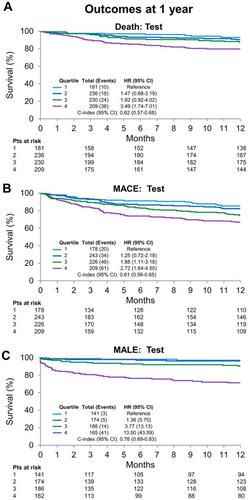当前位置:
X-MOL 学术
›
J. Vasc. Surg.
›
论文详情
Our official English website, www.x-mol.net, welcomes your feedback! (Note: you will need to create a separate account there.)
Artificial intelligence of arterial Doppler waveforms to predict major adverse outcomes among patients with diabetes mellitus
Journal of Vascular Surgery ( IF 4.3 ) Pub Date : 2024-02-28 , DOI: 10.1016/j.jvs.2024.02.024 Robert D. McBane , Dennis H. Murphree , David Liedl , Francisco Lopez-Jimenez , Adelaide Arruda-Olson , Christopher G. Scott , Naresh Prodduturi , Steve E. Nowakowski , Thom W. Rooke , Ana I. Casanegra , Waldemar E. Wysokinski , Damon E. Houghton , Kalpana Muthusamy , Paul W. Wennberg
Journal of Vascular Surgery ( IF 4.3 ) Pub Date : 2024-02-28 , DOI: 10.1016/j.jvs.2024.02.024 Robert D. McBane , Dennis H. Murphree , David Liedl , Francisco Lopez-Jimenez , Adelaide Arruda-Olson , Christopher G. Scott , Naresh Prodduturi , Steve E. Nowakowski , Thom W. Rooke , Ana I. Casanegra , Waldemar E. Wysokinski , Damon E. Houghton , Kalpana Muthusamy , Paul W. Wennberg

|
Patients with diabetes mellitus (DM) are at increased risk for peripheral artery disease (PAD) and its complications. Arterial calcification and non-compressibility may limit test interpretation in this population. Developing tools capable of identifying PAD and predicting major adverse cardiac event (MACE) and limb event (MALE) outcomes among patients with DM would be clinically useful. Deep neural network analysis of resting Doppler arterial waveforms was used to detect PAD among patients with DM and to identify those at greatest risk for major adverse outcome events. Consecutive patients with DM undergoing lower limb arterial testing (April 1, 2015-December 30, 2020) were randomly allocated to training, validation, and testing subsets (60%, 20%, and 20%). Deep neural networks were trained on resting posterior tibial arterial Doppler waveforms to predict all-cause mortality, MACE, and MALE at 5 years using quartiles based on the distribution of the prediction score. Among 11,384 total patients, 4211 patients with DM met study criteria (mean age, 68.6 ± 11.9 years; 32.0% female). After allocating the training and validation subsets, the final test subset included 856 patients. During follow-up, there were 262 deaths, 319 MACE, and 99 MALE. Patients in the upper quartile of prediction based on deep neural network analysis of the posterior tibial artery waveform provided independent prediction of death (hazard ratio [HR], 3.58; 95% confidence interval [CI], 2.31-5.56), MACE (HR, 2.06; 95% CI, 1.49-2.91), and MALE (HR, 13.50; 95% CI, 5.83-31.27). An artificial intelligence enabled analysis of a resting Doppler arterial waveform permits identification of major adverse outcomes including all-cause mortality, MACE, and MALE among patients with DM.
中文翻译:

动脉多普勒波形的人工智能可预测糖尿病患者的主要不良后果
糖尿病 (DM) 患者患外周动脉疾病 (PAD) 及其并发症的风险增加。动脉钙化和不可压缩性可能会限制该人群的测试解释。开发能够识别 PAD 并预测 DM 患者主要不良心脏事件 (MACE) 和肢体事件 (MALE) 结果的工具将在临床上有用。使用静息多普勒动脉波形的深度神经网络分析来检测 DM 患者的 PAD,并识别那些发生主要不良结果事件的风险最大的患者。连续接受下肢动脉测试的 DM 患者(2015 年 4 月 1 日至 2020 年 12 月 30 日)被随机分配到训练、验证和测试子集(60%、20% 和 20%)。使用静息胫骨后动脉多普勒波形对深度神经网络进行训练,以根据预测分数的分布使用四分位数来预测 5 年时的全因死亡率、MACE 和 MALE。在 11,384 名患者中,4211 名 DM 患者符合研究标准(平均年龄,68.6 ± 11.9 岁;32.0% 为女性)。分配训练和验证子集后,最终测试子集包括 856 名患者。随访期间,共有 262 例死亡、319 例 MACE 和 99 例 MALE。基于胫后动脉波形深度神经网络分析的预测上四分位数的患者提供了死亡独立预测(风险比 [HR],3.58;95% 置信区间 [CI],2.31-5.56)、MACE(HR, 2.06;95% CI,1.49-2.91)和男性(HR,13.50;95% CI,5.83-31.27)。通过人工智能对静息多普勒动脉波形进行分析,可以识别 DM 患者的主要不良后果,包括全因死亡率、MACE 和 MALE。
更新日期:2024-02-28
中文翻译:

动脉多普勒波形的人工智能可预测糖尿病患者的主要不良后果
糖尿病 (DM) 患者患外周动脉疾病 (PAD) 及其并发症的风险增加。动脉钙化和不可压缩性可能会限制该人群的测试解释。开发能够识别 PAD 并预测 DM 患者主要不良心脏事件 (MACE) 和肢体事件 (MALE) 结果的工具将在临床上有用。使用静息多普勒动脉波形的深度神经网络分析来检测 DM 患者的 PAD,并识别那些发生主要不良结果事件的风险最大的患者。连续接受下肢动脉测试的 DM 患者(2015 年 4 月 1 日至 2020 年 12 月 30 日)被随机分配到训练、验证和测试子集(60%、20% 和 20%)。使用静息胫骨后动脉多普勒波形对深度神经网络进行训练,以根据预测分数的分布使用四分位数来预测 5 年时的全因死亡率、MACE 和 MALE。在 11,384 名患者中,4211 名 DM 患者符合研究标准(平均年龄,68.6 ± 11.9 岁;32.0% 为女性)。分配训练和验证子集后,最终测试子集包括 856 名患者。随访期间,共有 262 例死亡、319 例 MACE 和 99 例 MALE。基于胫后动脉波形深度神经网络分析的预测上四分位数的患者提供了死亡独立预测(风险比 [HR],3.58;95% 置信区间 [CI],2.31-5.56)、MACE(HR, 2.06;95% CI,1.49-2.91)和男性(HR,13.50;95% CI,5.83-31.27)。通过人工智能对静息多普勒动脉波形进行分析,可以识别 DM 患者的主要不良后果,包括全因死亡率、MACE 和 MALE。



























 京公网安备 11010802027423号
京公网安备 11010802027423号